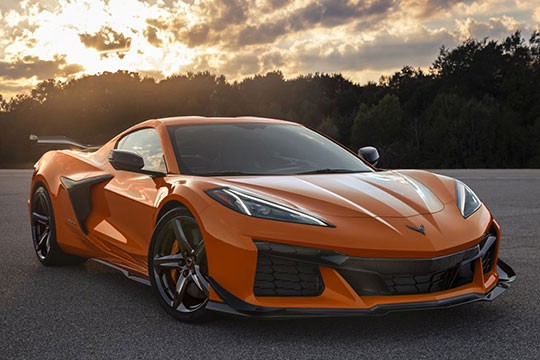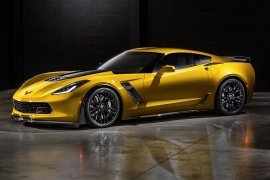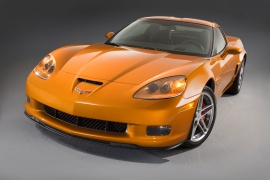CHEVROLET Corvette Z06 Models/Series Timeline, Specifications & Photos
First production year: 2008
Engines: Gasoline
Body style: Coupé (two-door)
Chevrolet continued the Corvette saga with the introduction of the Z06 version for the C8. Thus, when most carmakers were concerned about electrification, the American carmaker indulged itself with another extreme version of their supercar.
One of the most influential people in the Corvette evolution was Zora Arkus-Duntov. He created a particular version for the 1963 model with a fuel-injected V8 that offered 360 hp. It was a high value for those times. Fast forward to 2022, and the C8 generation came as the supercar envisioned by the brilliant engineer: a mid-mounted engine and a more powerful version: the 2022 Z06.
On the outside, the Z06 featured a wider stance by 3.6” (9.4 cm) than its Stingray sibling. At the front, a redesigned bumper sported a wider air-intake for enhanced cooling. From its sides, the 20” front and 21” light-alloy-wheels wore Michelin Cup 2 R ZP tires. At the same time, the carmaker placed an adjustable wing at the back for improved cornering speed and handling.
The interior featured a similar design with the rest of the stable, but GM added a carbon-fiber trim package. Thus, it completed the overall race-inspired experience for the two occupants of the cockpit.
Behind the cabin, GM installed a state-of-the-art naturally aspirated V8 engine. Named LT6, the 5.5-liter powerplant developed the highest power for any atmospheric V8s ever installed in a production vehicle to that date. The engine sent its 670 hp to the rear wheels via an eight-speed (dual-clutch) automatic gearbox. The final drive offered a 5.56 ratio, made for enhanced acceleration times.
The seventh generation of the Corvette lived its final years when Chevrolet introduced the Z06 version of America’s fastest sports car before re-inventing it as a mid-engined, proper supercar.
Chevrolet introduced the Corvette nameplate in 1963 as a small, two-door convertible. It wasn’t an instant hit due to its slant-six engine and unusual shape, but it became a best-seller in the carmaker’s inventory. After Zora Arkus-Duntov joined the team, the Corvette rocketed into the sportscar arena and stayed there for the decades to come. In September 2013, Chevrolet introduced the seventh generation of this beloved nameplate. In the following year, and at the 2014 North American International Auto Show, the Corvette family grew with the addition of the Z06 version for the 2015 model year.
When GM launched the car, the audience was in shock. Not only that the Z06 was the most powerful and fastest version of the lineup, but it showed it. The front fascia sported swept-back headlights adorned with LED daytime running lights on their lower side in a boomerang shape. The bumper featured a broad black grille in the air dam and a splitter underneath it, which enhanced the car’s aerodynamics. Moreover, the hood had vents on it in front of a bulged area, suggesting that there was a bigger powerplant underneath, or at least a supercharger. From its profile, the functional vents behind the front wheel arches extracted the air trapped inside the wheel wells and decreased the aerodynamic lift of the car. But the automaker didn’t stop there and included a new set of side sills and air intakes in front of the rear wheels, while at the back, it placed a wing on the rear panel.
For many years, the Corvette was criticized by many for poor interior quality. Along with the seventh generation of this nameplate, things improved drastically. As a result, the C7 Z06 featured a Mullan or Nappa leather-wrapped interior (depending on the grade) with high-bolstered bucket seats that could keep their occupants in place during high-speed cornering. The dashboard layout was similar to its siblings and featured a wide rev counter in the middle flanked by a speedometer on the left and the fuel and temperature gauges on the right. On the center stack, Chevrolet added a touchscreen for the infotainment system, which didn’t look like it was an off-the-shelf product. Furthermore, the center console housed a rotary dial that controlled it.
Still, customers were mostly attracted by what happened under the hood. There, Chevy dropped the LT4 supercharged engine that produced 650 HP (659 PS) and a massive torque of 650 lb-ft (850 Nm) paired to either an eight-speed automatic transmission or an unusual seven-speed manual gearbox. All the oomph went to the rear wheels via an electronically controlled limited-slip differential. The car also featured various functions, such as launch control and a three-level adjustable aerodynamic package.
The 2008 Corvette Z06 was the beast unleashed by General Motor in a final attempt to create a strong image of a dying breed: the large V-8 engined American sports cars.
Back in 2008, General Motors was in deep trouble. The world financial crisis took its toll on the American carmaker who faced the difficult decision to pull back from Europe. Despite that, the management approved the Z06 project, and it wasn't just a "let's put a bigger engine and call it a day" situation. It was much more than that. After all, they were selling the most iconic American sports car of all time, the Corvette.
The engineers made the Z06 with the best materials and best solutions and resulted in a Corvette as fast as an Italian supercar. The carbon-fiber bumpers sported a broad air intake to cool the massive engine under the hood. There was a gap behind the doors to open them on its sides since there were no visible door-handles. In the back, there was no massive, show-off wing on the liftgate.
GM didn't want to make an expensive interior. Sure, it used leather-clad sport bucket seats with high bolstering. Its plastics from the dashboard were similar to those existing in budget or fleet cars. But it added a head-up display that showed a G-meter on the windshield, not on a separate panel. The infotainment unit offered a navigation system but not a touch-screen.
But the Z06 was mighty for its performance-oriented details. GM used hydroformed aluminum elements for the safety cell, magnesium, and high-strength steel for the chassis. After GM did everything to make the car lighter, it dropped a 7.0-liter V-8 engine under the hood and sent 505 hp to the rear wheels via a six-speed manual only. Its magnetorheological dampers increased the cornering speed and proved that the Corvette was not a straight-line racer. It could do corners as well with over 1 g lateral acceleration and still keep the trace.


